Financial Analysis Report: Telstra & TPG Telecom Ltd (MBA711)
VerifiedAdded on 2020/03/01
|10
|2039
|74
Report
AI Summary
This report provides a comprehensive financial analysis of Telstra and TPG Telecom Ltd, focusing on their accounting practices and financial performance. The analysis includes a detailed examination of the depreciation policies employed by both companies, highlighting the straight-line method and its impact on profitability. It also explores the inventory valuation methods used, comparing their approaches to cost versus net realizable value and the implications for profit. Furthermore, the report identifies and analyzes the intangible assets of each company, such as goodwill, software, and customer bases, and evaluates their valuation methods. A comparative summary of the accounting policies adopted by both companies is presented, covering depreciation, inventory valuation, and intangible assets. The report concludes with a recommendation based on the comparative analysis, offering insights into the companies' financial strategies and providing a basis for informed decision-making. The report is based on the 2016 annual reports of both companies, providing up-to-date financial information and analysis.
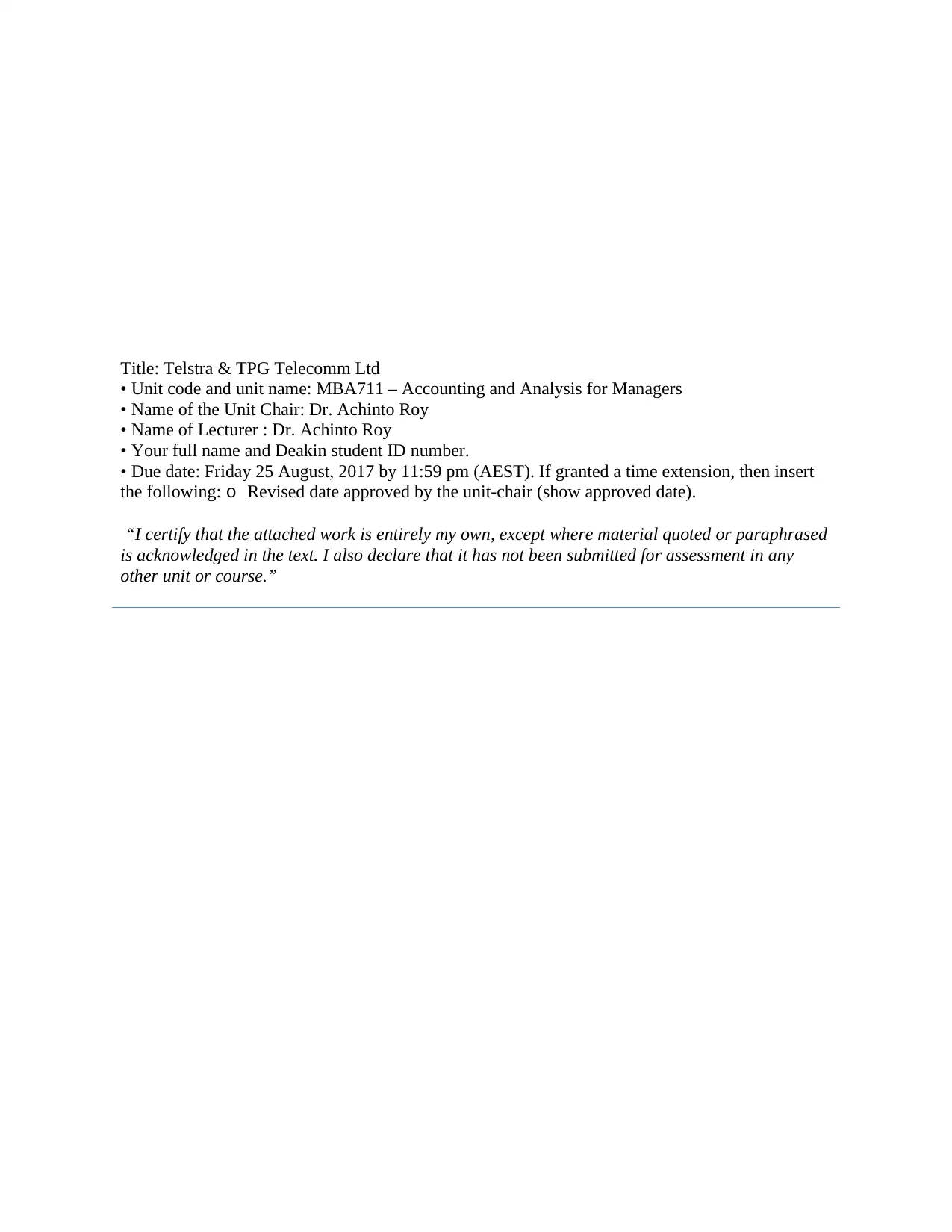
Title: Telstra & TPG Telecomm Ltd
• Unit code and unit name: MBA711 – Accounting and Analysis for Managers
• Name of the Unit Chair: Dr. Achinto Roy
• Name of Lecturer : Dr. Achinto Roy
• Your full name and Deakin student ID number.
• Due date: Friday 25 August, 2017 by 11:59 pm (AEST). If granted a time extension, then insert
the following: o Revised date approved by the unit-chair (show approved date).
“I certify that the attached work is entirely my own, except where material quoted or paraphrased
is acknowledged in the text. I also declare that it has not been submitted for assessment in any
other unit or course.”
• Unit code and unit name: MBA711 – Accounting and Analysis for Managers
• Name of the Unit Chair: Dr. Achinto Roy
• Name of Lecturer : Dr. Achinto Roy
• Your full name and Deakin student ID number.
• Due date: Friday 25 August, 2017 by 11:59 pm (AEST). If granted a time extension, then insert
the following: o Revised date approved by the unit-chair (show approved date).
“I certify that the attached work is entirely my own, except where material quoted or paraphrased
is acknowledged in the text. I also declare that it has not been submitted for assessment in any
other unit or course.”
Paraphrase This Document
Need a fresh take? Get an instant paraphrase of this document with our AI Paraphraser
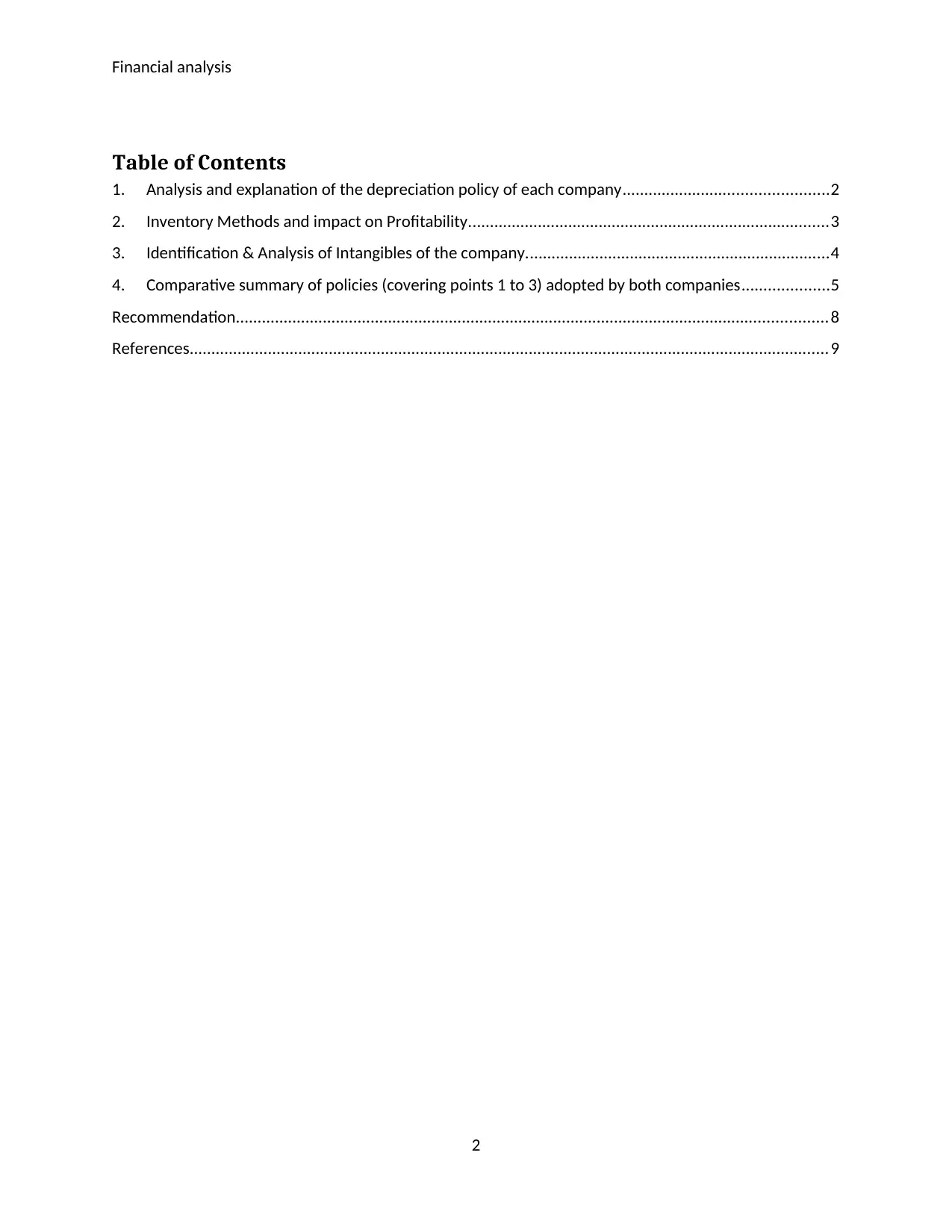
Financial analysis
Table of Contents
1. Analysis and explanation of the depreciation policy of each company...............................................2
2. Inventory Methods and impact on Profitability...................................................................................3
3. Identification & Analysis of Intangibles of the company......................................................................4
4. Comparative summary of policies (covering points 1 to 3) adopted by both companies....................5
Recommendation........................................................................................................................................8
References...................................................................................................................................................9
2
Table of Contents
1. Analysis and explanation of the depreciation policy of each company...............................................2
2. Inventory Methods and impact on Profitability...................................................................................3
3. Identification & Analysis of Intangibles of the company......................................................................4
4. Comparative summary of policies (covering points 1 to 3) adopted by both companies....................5
Recommendation........................................................................................................................................8
References...................................................................................................................................................9
2
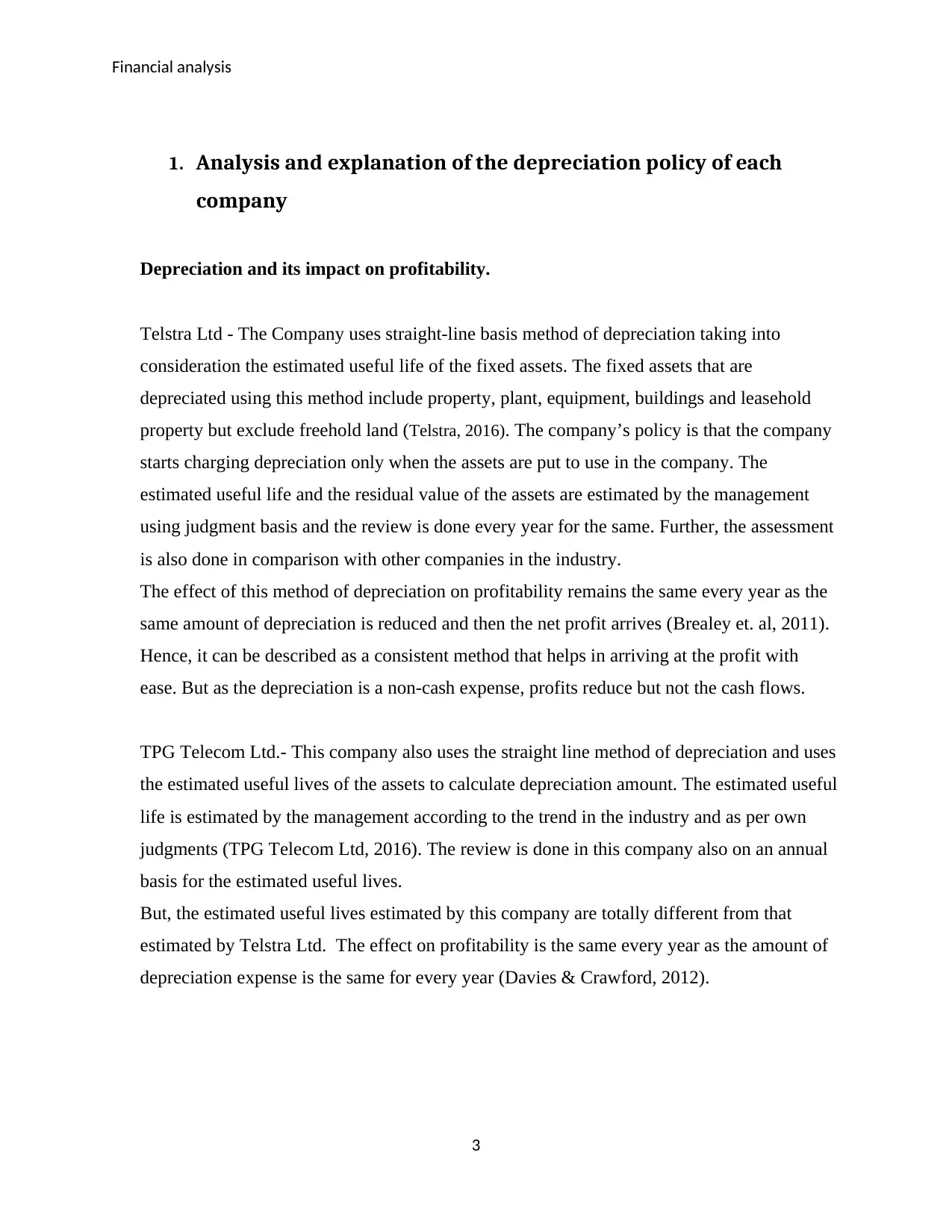
Financial analysis
1. Analysis and explanation of the depreciation policy of each
company
Depreciation and its impact on profitability.
Telstra Ltd - The Company uses straight-line basis method of depreciation taking into
consideration the estimated useful life of the fixed assets. The fixed assets that are
depreciated using this method include property, plant, equipment, buildings and leasehold
property but exclude freehold land (Telstra, 2016). The company’s policy is that the company
starts charging depreciation only when the assets are put to use in the company. The
estimated useful life and the residual value of the assets are estimated by the management
using judgment basis and the review is done every year for the same. Further, the assessment
is also done in comparison with other companies in the industry.
The effect of this method of depreciation on profitability remains the same every year as the
same amount of depreciation is reduced and then the net profit arrives (Brealey et. al, 2011).
Hence, it can be described as a consistent method that helps in arriving at the profit with
ease. But as the depreciation is a non-cash expense, profits reduce but not the cash flows.
TPG Telecom Ltd.- This company also uses the straight line method of depreciation and uses
the estimated useful lives of the assets to calculate depreciation amount. The estimated useful
life is estimated by the management according to the trend in the industry and as per own
judgments (TPG Telecom Ltd, 2016). The review is done in this company also on an annual
basis for the estimated useful lives.
But, the estimated useful lives estimated by this company are totally different from that
estimated by Telstra Ltd. The effect on profitability is the same every year as the amount of
depreciation expense is the same for every year (Davies & Crawford, 2012).
3
1. Analysis and explanation of the depreciation policy of each
company
Depreciation and its impact on profitability.
Telstra Ltd - The Company uses straight-line basis method of depreciation taking into
consideration the estimated useful life of the fixed assets. The fixed assets that are
depreciated using this method include property, plant, equipment, buildings and leasehold
property but exclude freehold land (Telstra, 2016). The company’s policy is that the company
starts charging depreciation only when the assets are put to use in the company. The
estimated useful life and the residual value of the assets are estimated by the management
using judgment basis and the review is done every year for the same. Further, the assessment
is also done in comparison with other companies in the industry.
The effect of this method of depreciation on profitability remains the same every year as the
same amount of depreciation is reduced and then the net profit arrives (Brealey et. al, 2011).
Hence, it can be described as a consistent method that helps in arriving at the profit with
ease. But as the depreciation is a non-cash expense, profits reduce but not the cash flows.
TPG Telecom Ltd.- This company also uses the straight line method of depreciation and uses
the estimated useful lives of the assets to calculate depreciation amount. The estimated useful
life is estimated by the management according to the trend in the industry and as per own
judgments (TPG Telecom Ltd, 2016). The review is done in this company also on an annual
basis for the estimated useful lives.
But, the estimated useful lives estimated by this company are totally different from that
estimated by Telstra Ltd. The effect on profitability is the same every year as the amount of
depreciation expense is the same for every year (Davies & Crawford, 2012).
3
⊘ This is a preview!⊘
Do you want full access?
Subscribe today to unlock all pages.

Trusted by 1+ million students worldwide
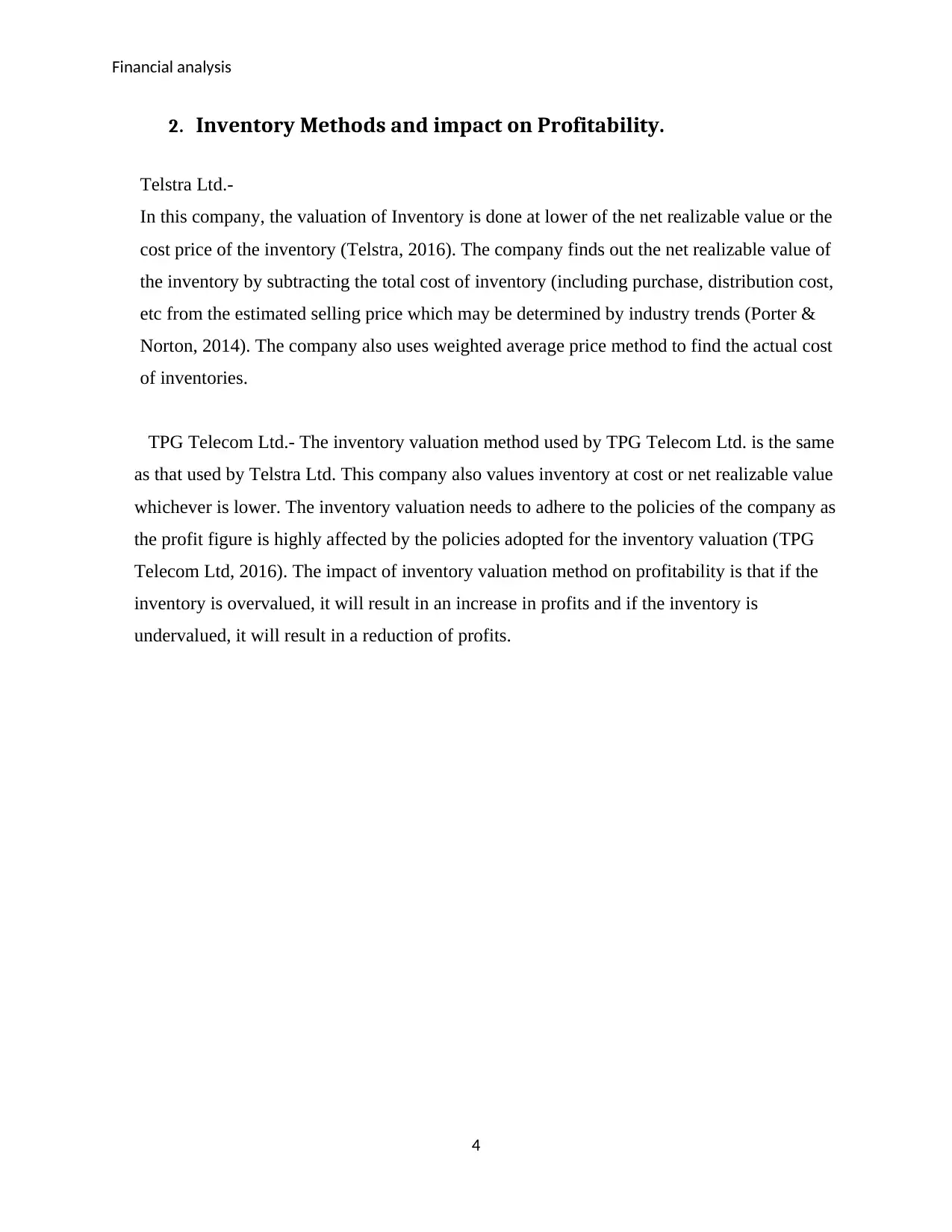
Financial analysis
2. Inventory Methods and impact on Profitability.
Telstra Ltd.-
In this company, the valuation of Inventory is done at lower of the net realizable value or the
cost price of the inventory (Telstra, 2016). The company finds out the net realizable value of
the inventory by subtracting the total cost of inventory (including purchase, distribution cost,
etc from the estimated selling price which may be determined by industry trends (Porter &
Norton, 2014). The company also uses weighted average price method to find the actual cost
of inventories.
TPG Telecom Ltd.- The inventory valuation method used by TPG Telecom Ltd. is the same
as that used by Telstra Ltd. This company also values inventory at cost or net realizable value
whichever is lower. The inventory valuation needs to adhere to the policies of the company as
the profit figure is highly affected by the policies adopted for the inventory valuation (TPG
Telecom Ltd, 2016). The impact of inventory valuation method on profitability is that if the
inventory is overvalued, it will result in an increase in profits and if the inventory is
undervalued, it will result in a reduction of profits.
4
2. Inventory Methods and impact on Profitability.
Telstra Ltd.-
In this company, the valuation of Inventory is done at lower of the net realizable value or the
cost price of the inventory (Telstra, 2016). The company finds out the net realizable value of
the inventory by subtracting the total cost of inventory (including purchase, distribution cost,
etc from the estimated selling price which may be determined by industry trends (Porter &
Norton, 2014). The company also uses weighted average price method to find the actual cost
of inventories.
TPG Telecom Ltd.- The inventory valuation method used by TPG Telecom Ltd. is the same
as that used by Telstra Ltd. This company also values inventory at cost or net realizable value
whichever is lower. The inventory valuation needs to adhere to the policies of the company as
the profit figure is highly affected by the policies adopted for the inventory valuation (TPG
Telecom Ltd, 2016). The impact of inventory valuation method on profitability is that if the
inventory is overvalued, it will result in an increase in profits and if the inventory is
undervalued, it will result in a reduction of profits.
4
Paraphrase This Document
Need a fresh take? Get an instant paraphrase of this document with our AI Paraphraser
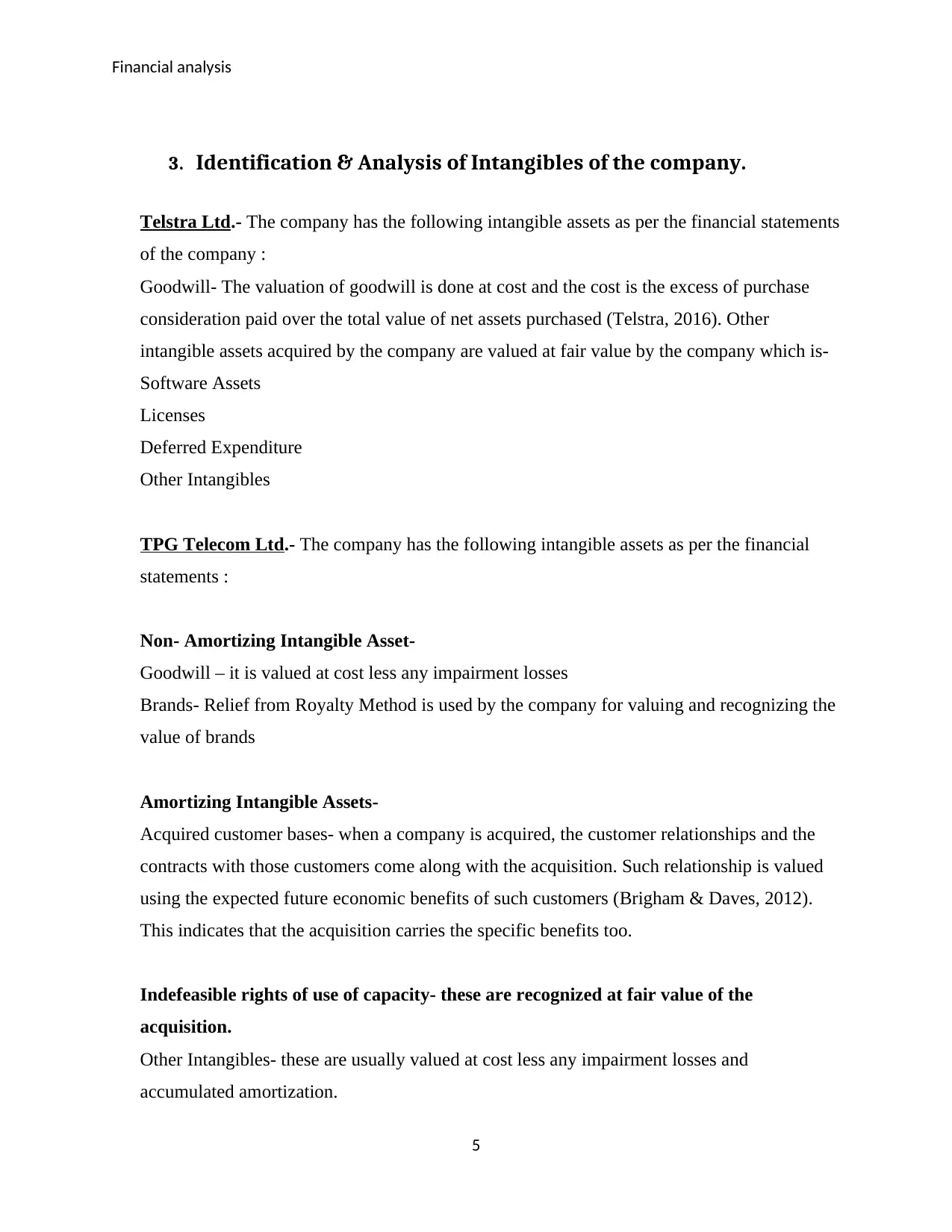
Financial analysis
3. Identification & Analysis of Intangibles of the company.
Telstra Ltd.- The company has the following intangible assets as per the financial statements
of the company :
Goodwill- The valuation of goodwill is done at cost and the cost is the excess of purchase
consideration paid over the total value of net assets purchased (Telstra, 2016). Other
intangible assets acquired by the company are valued at fair value by the company which is-
Software Assets
Licenses
Deferred Expenditure
Other Intangibles
TPG Telecom Ltd.- The company has the following intangible assets as per the financial
statements :
Non- Amortizing Intangible Asset-
Goodwill – it is valued at cost less any impairment losses
Brands- Relief from Royalty Method is used by the company for valuing and recognizing the
value of brands
Amortizing Intangible Assets-
Acquired customer bases- when a company is acquired, the customer relationships and the
contracts with those customers come along with the acquisition. Such relationship is valued
using the expected future economic benefits of such customers (Brigham & Daves, 2012).
This indicates that the acquisition carries the specific benefits too.
Indefeasible rights of use of capacity- these are recognized at fair value of the
acquisition.
Other Intangibles- these are usually valued at cost less any impairment losses and
accumulated amortization.
5
3. Identification & Analysis of Intangibles of the company.
Telstra Ltd.- The company has the following intangible assets as per the financial statements
of the company :
Goodwill- The valuation of goodwill is done at cost and the cost is the excess of purchase
consideration paid over the total value of net assets purchased (Telstra, 2016). Other
intangible assets acquired by the company are valued at fair value by the company which is-
Software Assets
Licenses
Deferred Expenditure
Other Intangibles
TPG Telecom Ltd.- The company has the following intangible assets as per the financial
statements :
Non- Amortizing Intangible Asset-
Goodwill – it is valued at cost less any impairment losses
Brands- Relief from Royalty Method is used by the company for valuing and recognizing the
value of brands
Amortizing Intangible Assets-
Acquired customer bases- when a company is acquired, the customer relationships and the
contracts with those customers come along with the acquisition. Such relationship is valued
using the expected future economic benefits of such customers (Brigham & Daves, 2012).
This indicates that the acquisition carries the specific benefits too.
Indefeasible rights of use of capacity- these are recognized at fair value of the
acquisition.
Other Intangibles- these are usually valued at cost less any impairment losses and
accumulated amortization.
5
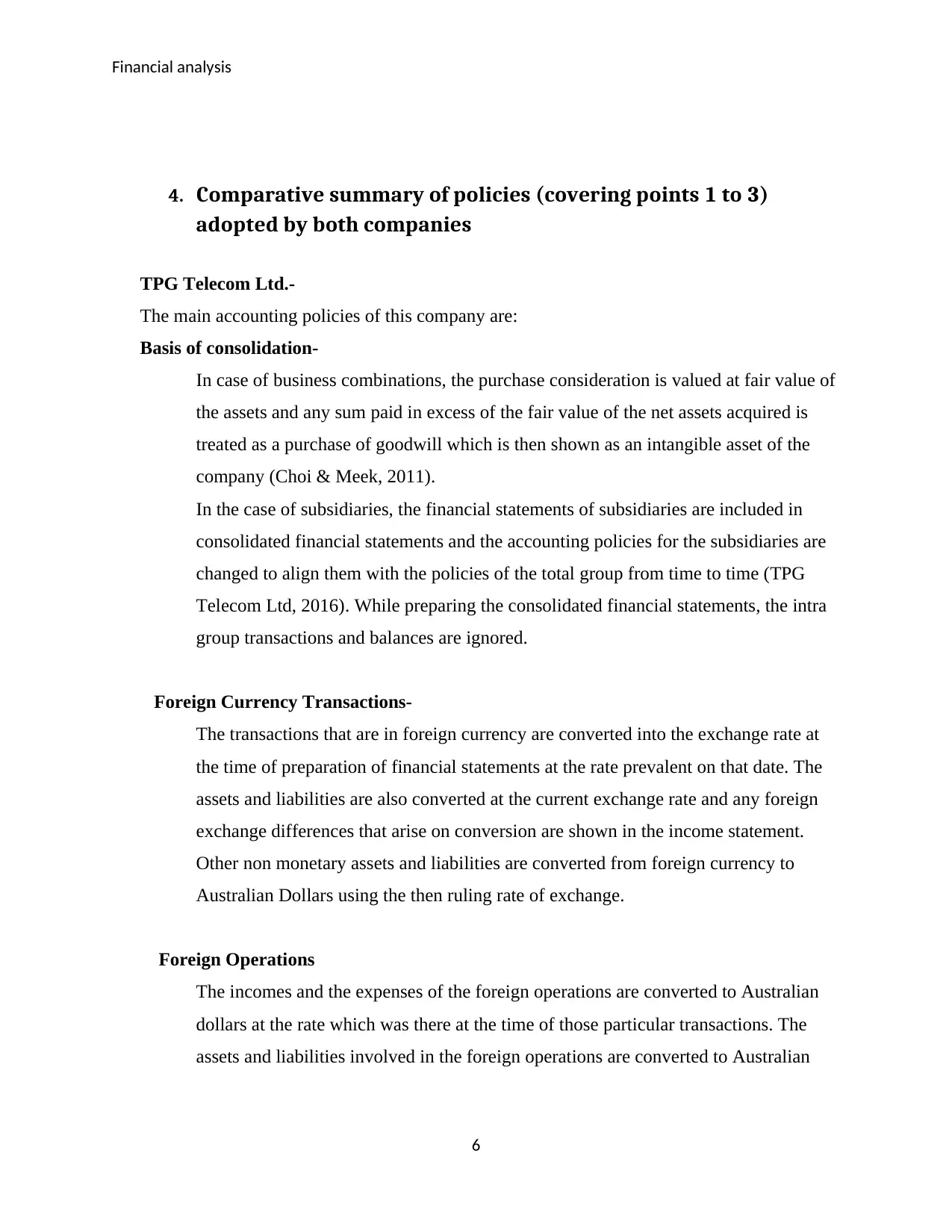
Financial analysis
4. Comparative summary of policies (covering points 1 to 3)
adopted by both companies
TPG Telecom Ltd.-
The main accounting policies of this company are:
Basis of consolidation-
In case of business combinations, the purchase consideration is valued at fair value of
the assets and any sum paid in excess of the fair value of the net assets acquired is
treated as a purchase of goodwill which is then shown as an intangible asset of the
company (Choi & Meek, 2011).
In the case of subsidiaries, the financial statements of subsidiaries are included in
consolidated financial statements and the accounting policies for the subsidiaries are
changed to align them with the policies of the total group from time to time (TPG
Telecom Ltd, 2016). While preparing the consolidated financial statements, the intra
group transactions and balances are ignored.
Foreign Currency Transactions-
The transactions that are in foreign currency are converted into the exchange rate at
the time of preparation of financial statements at the rate prevalent on that date. The
assets and liabilities are also converted at the current exchange rate and any foreign
exchange differences that arise on conversion are shown in the income statement.
Other non monetary assets and liabilities are converted from foreign currency to
Australian Dollars using the then ruling rate of exchange.
Foreign Operations
The incomes and the expenses of the foreign operations are converted to Australian
dollars at the rate which was there at the time of those particular transactions. The
assets and liabilities involved in the foreign operations are converted to Australian
6
4. Comparative summary of policies (covering points 1 to 3)
adopted by both companies
TPG Telecom Ltd.-
The main accounting policies of this company are:
Basis of consolidation-
In case of business combinations, the purchase consideration is valued at fair value of
the assets and any sum paid in excess of the fair value of the net assets acquired is
treated as a purchase of goodwill which is then shown as an intangible asset of the
company (Choi & Meek, 2011).
In the case of subsidiaries, the financial statements of subsidiaries are included in
consolidated financial statements and the accounting policies for the subsidiaries are
changed to align them with the policies of the total group from time to time (TPG
Telecom Ltd, 2016). While preparing the consolidated financial statements, the intra
group transactions and balances are ignored.
Foreign Currency Transactions-
The transactions that are in foreign currency are converted into the exchange rate at
the time of preparation of financial statements at the rate prevalent on that date. The
assets and liabilities are also converted at the current exchange rate and any foreign
exchange differences that arise on conversion are shown in the income statement.
Other non monetary assets and liabilities are converted from foreign currency to
Australian Dollars using the then ruling rate of exchange.
Foreign Operations
The incomes and the expenses of the foreign operations are converted to Australian
dollars at the rate which was there at the time of those particular transactions. The
assets and liabilities involved in the foreign operations are converted to Australian
6
⊘ This is a preview!⊘
Do you want full access?
Subscribe today to unlock all pages.

Trusted by 1+ million students worldwide
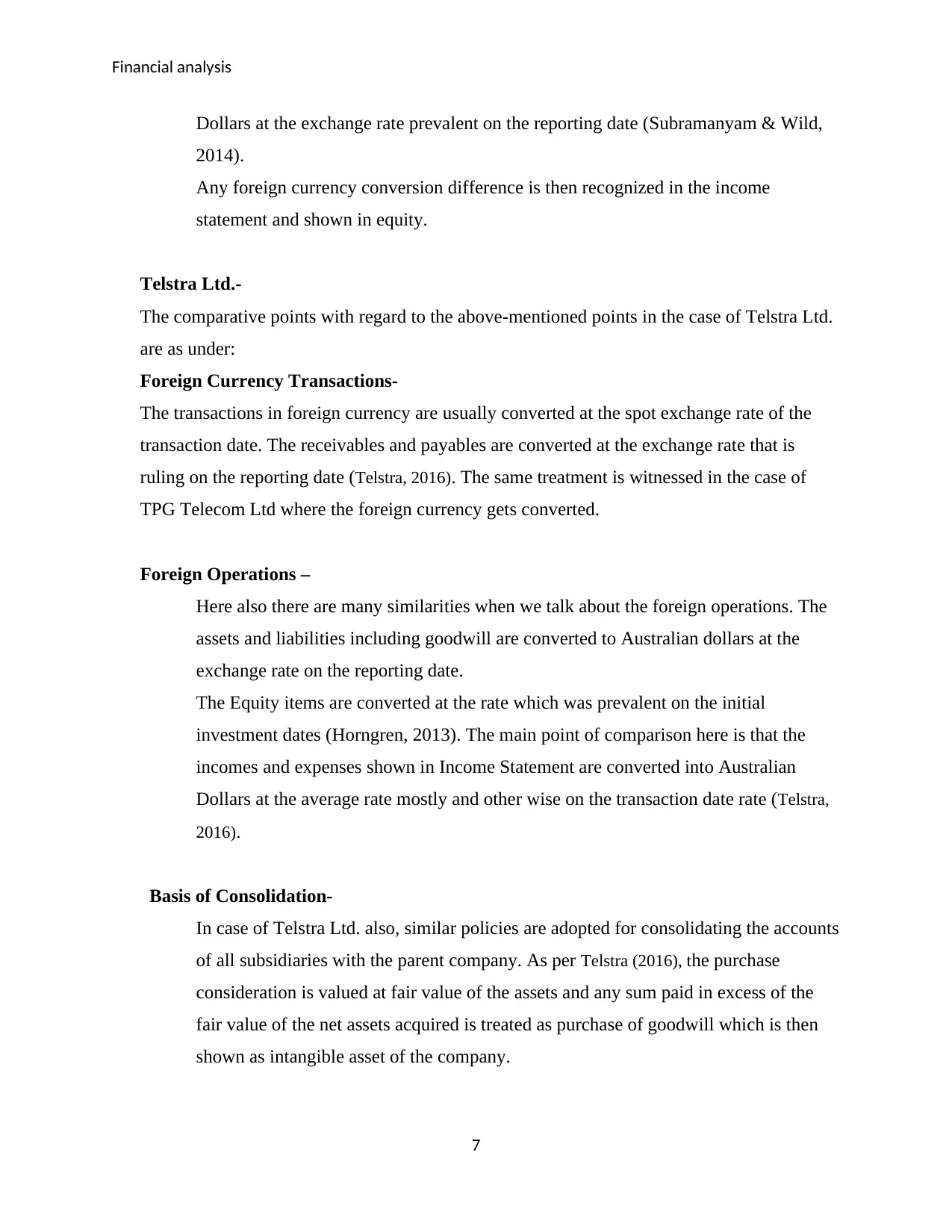
Financial analysis
Dollars at the exchange rate prevalent on the reporting date (Subramanyam & Wild,
2014).
Any foreign currency conversion difference is then recognized in the income
statement and shown in equity.
Telstra Ltd.-
The comparative points with regard to the above-mentioned points in the case of Telstra Ltd.
are as under:
Foreign Currency Transactions-
The transactions in foreign currency are usually converted at the spot exchange rate of the
transaction date. The receivables and payables are converted at the exchange rate that is
ruling on the reporting date (Telstra, 2016). The same treatment is witnessed in the case of
TPG Telecom Ltd where the foreign currency gets converted.
Foreign Operations –
Here also there are many similarities when we talk about the foreign operations. The
assets and liabilities including goodwill are converted to Australian dollars at the
exchange rate on the reporting date.
The Equity items are converted at the rate which was prevalent on the initial
investment dates (Horngren, 2013). The main point of comparison here is that the
incomes and expenses shown in Income Statement are converted into Australian
Dollars at the average rate mostly and other wise on the transaction date rate (Telstra,
2016).
Basis of Consolidation-
In case of Telstra Ltd. also, similar policies are adopted for consolidating the accounts
of all subsidiaries with the parent company. As per Telstra (2016), the purchase
consideration is valued at fair value of the assets and any sum paid in excess of the
fair value of the net assets acquired is treated as purchase of goodwill which is then
shown as intangible asset of the company.
7
Dollars at the exchange rate prevalent on the reporting date (Subramanyam & Wild,
2014).
Any foreign currency conversion difference is then recognized in the income
statement and shown in equity.
Telstra Ltd.-
The comparative points with regard to the above-mentioned points in the case of Telstra Ltd.
are as under:
Foreign Currency Transactions-
The transactions in foreign currency are usually converted at the spot exchange rate of the
transaction date. The receivables and payables are converted at the exchange rate that is
ruling on the reporting date (Telstra, 2016). The same treatment is witnessed in the case of
TPG Telecom Ltd where the foreign currency gets converted.
Foreign Operations –
Here also there are many similarities when we talk about the foreign operations. The
assets and liabilities including goodwill are converted to Australian dollars at the
exchange rate on the reporting date.
The Equity items are converted at the rate which was prevalent on the initial
investment dates (Horngren, 2013). The main point of comparison here is that the
incomes and expenses shown in Income Statement are converted into Australian
Dollars at the average rate mostly and other wise on the transaction date rate (Telstra,
2016).
Basis of Consolidation-
In case of Telstra Ltd. also, similar policies are adopted for consolidating the accounts
of all subsidiaries with the parent company. As per Telstra (2016), the purchase
consideration is valued at fair value of the assets and any sum paid in excess of the
fair value of the net assets acquired is treated as purchase of goodwill which is then
shown as intangible asset of the company.
7
Paraphrase This Document
Need a fresh take? Get an instant paraphrase of this document with our AI Paraphraser
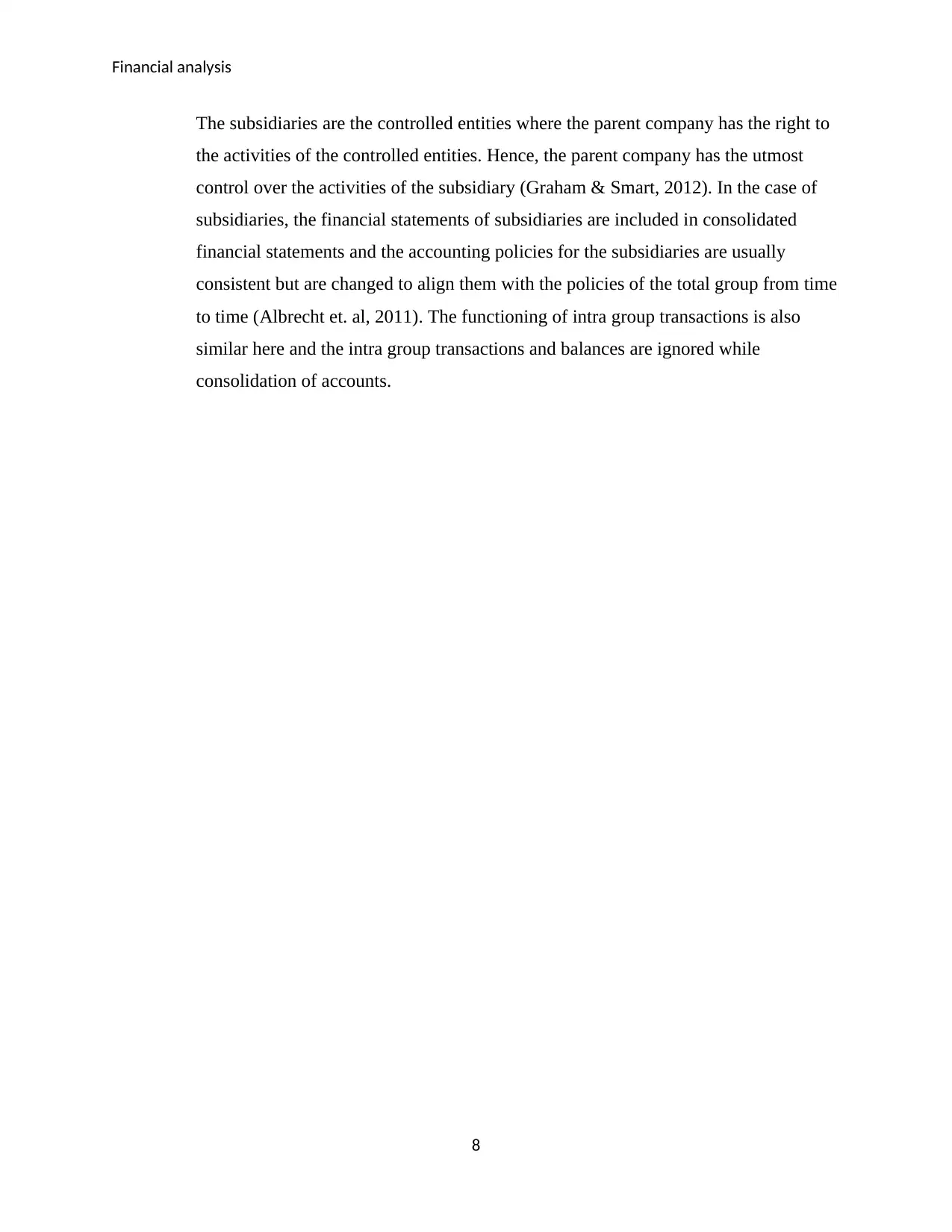
Financial analysis
The subsidiaries are the controlled entities where the parent company has the right to
the activities of the controlled entities. Hence, the parent company has the utmost
control over the activities of the subsidiary (Graham & Smart, 2012). In the case of
subsidiaries, the financial statements of subsidiaries are included in consolidated
financial statements and the accounting policies for the subsidiaries are usually
consistent but are changed to align them with the policies of the total group from time
to time (Albrecht et. al, 2011). The functioning of intra group transactions is also
similar here and the intra group transactions and balances are ignored while
consolidation of accounts.
8
The subsidiaries are the controlled entities where the parent company has the right to
the activities of the controlled entities. Hence, the parent company has the utmost
control over the activities of the subsidiary (Graham & Smart, 2012). In the case of
subsidiaries, the financial statements of subsidiaries are included in consolidated
financial statements and the accounting policies for the subsidiaries are usually
consistent but are changed to align them with the policies of the total group from time
to time (Albrecht et. al, 2011). The functioning of intra group transactions is also
similar here and the intra group transactions and balances are ignored while
consolidation of accounts.
8
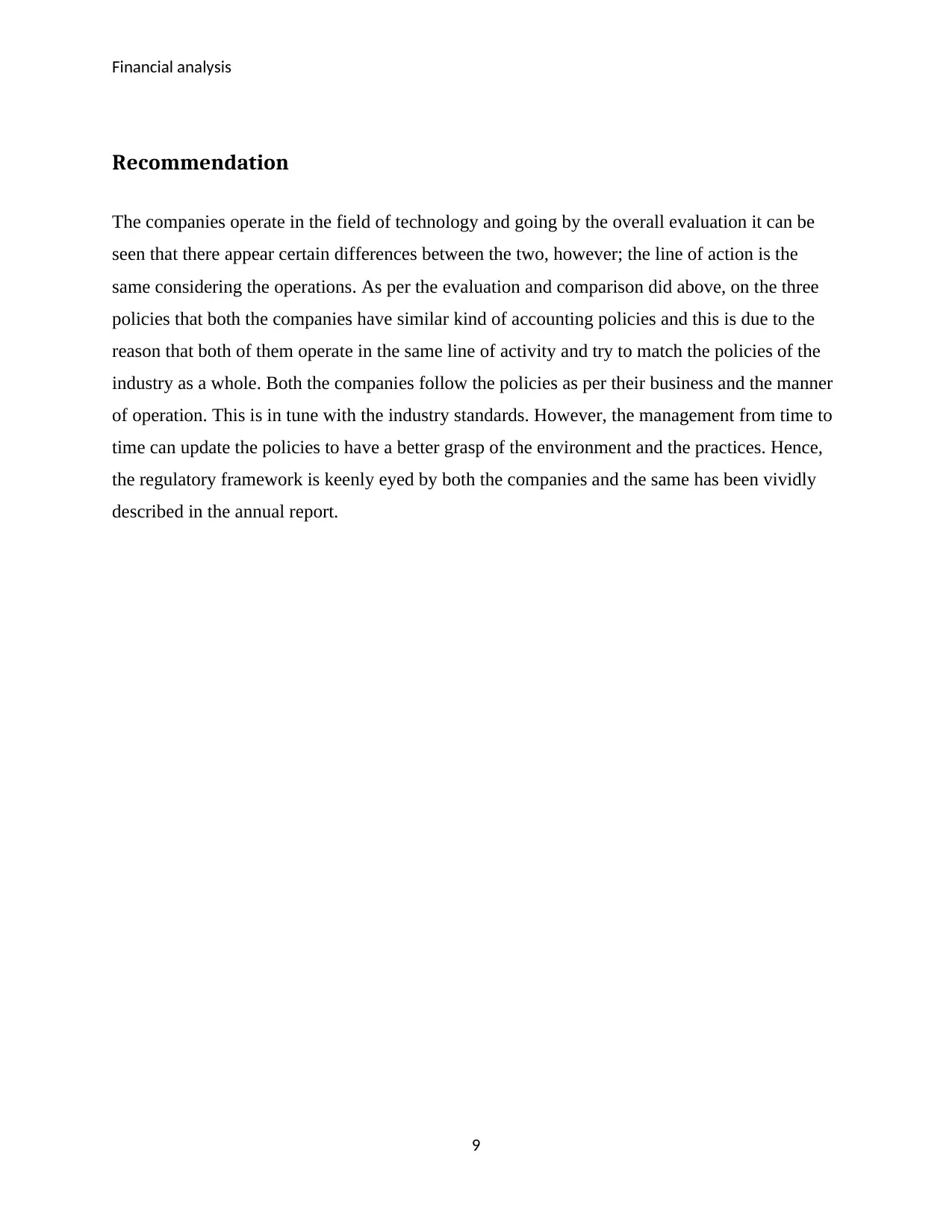
Financial analysis
Recommendation
The companies operate in the field of technology and going by the overall evaluation it can be
seen that there appear certain differences between the two, however; the line of action is the
same considering the operations. As per the evaluation and comparison did above, on the three
policies that both the companies have similar kind of accounting policies and this is due to the
reason that both of them operate in the same line of activity and try to match the policies of the
industry as a whole. Both the companies follow the policies as per their business and the manner
of operation. This is in tune with the industry standards. However, the management from time to
time can update the policies to have a better grasp of the environment and the practices. Hence,
the regulatory framework is keenly eyed by both the companies and the same has been vividly
described in the annual report.
9
Recommendation
The companies operate in the field of technology and going by the overall evaluation it can be
seen that there appear certain differences between the two, however; the line of action is the
same considering the operations. As per the evaluation and comparison did above, on the three
policies that both the companies have similar kind of accounting policies and this is due to the
reason that both of them operate in the same line of activity and try to match the policies of the
industry as a whole. Both the companies follow the policies as per their business and the manner
of operation. This is in tune with the industry standards. However, the management from time to
time can update the policies to have a better grasp of the environment and the practices. Hence,
the regulatory framework is keenly eyed by both the companies and the same has been vividly
described in the annual report.
9
⊘ This is a preview!⊘
Do you want full access?
Subscribe today to unlock all pages.

Trusted by 1+ million students worldwide
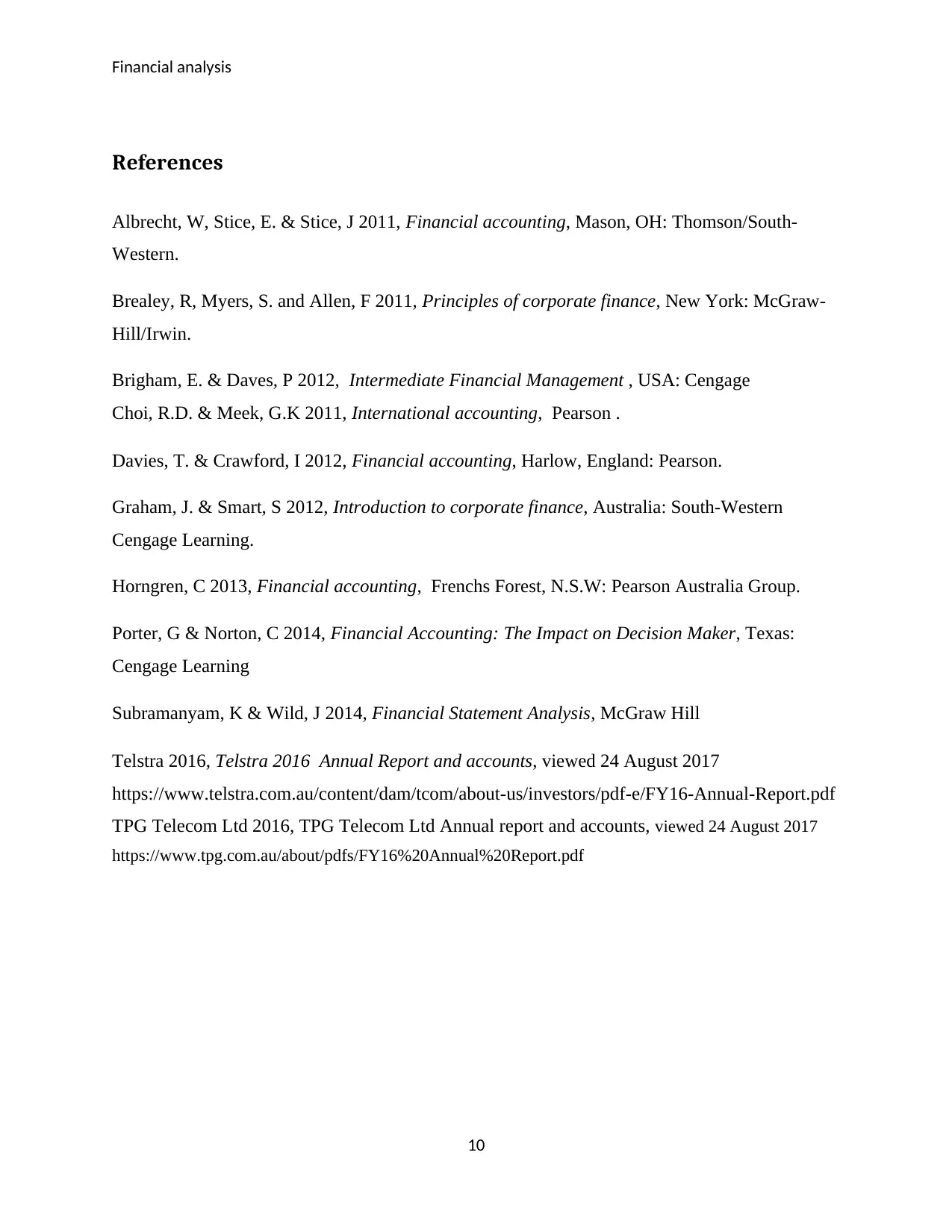
Financial analysis
References
Albrecht, W, Stice, E. & Stice, J 2011, Financial accounting, Mason, OH: Thomson/South-
Western.
Brealey, R, Myers, S. and Allen, F 2011, Principles of corporate finance, New York: McGraw-
Hill/Irwin.
Brigham, E. & Daves, P 2012, Intermediate Financial Management , USA: Cengage
Choi, R.D. & Meek, G.K 2011, International accounting, Pearson .
Davies, T. & Crawford, I 2012, Financial accounting, Harlow, England: Pearson.
Graham, J. & Smart, S 2012, Introduction to corporate finance, Australia: South-Western
Cengage Learning.
Horngren, C 2013, Financial accounting, Frenchs Forest, N.S.W: Pearson Australia Group.
Porter, G & Norton, C 2014, Financial Accounting: The Impact on Decision Maker, Texas:
Cengage Learning
Subramanyam, K & Wild, J 2014, Financial Statement Analysis, McGraw Hill
Telstra 2016, Telstra 2016 Annual Report and accounts, viewed 24 August 2017
https://www.telstra.com.au/content/dam/tcom/about-us/investors/pdf-e/FY16-Annual-Report.pdf
TPG Telecom Ltd 2016, TPG Telecom Ltd Annual report and accounts, viewed 24 August 2017
https://www.tpg.com.au/about/pdfs/FY16%20Annual%20Report.pdf
10
References
Albrecht, W, Stice, E. & Stice, J 2011, Financial accounting, Mason, OH: Thomson/South-
Western.
Brealey, R, Myers, S. and Allen, F 2011, Principles of corporate finance, New York: McGraw-
Hill/Irwin.
Brigham, E. & Daves, P 2012, Intermediate Financial Management , USA: Cengage
Choi, R.D. & Meek, G.K 2011, International accounting, Pearson .
Davies, T. & Crawford, I 2012, Financial accounting, Harlow, England: Pearson.
Graham, J. & Smart, S 2012, Introduction to corporate finance, Australia: South-Western
Cengage Learning.
Horngren, C 2013, Financial accounting, Frenchs Forest, N.S.W: Pearson Australia Group.
Porter, G & Norton, C 2014, Financial Accounting: The Impact on Decision Maker, Texas:
Cengage Learning
Subramanyam, K & Wild, J 2014, Financial Statement Analysis, McGraw Hill
Telstra 2016, Telstra 2016 Annual Report and accounts, viewed 24 August 2017
https://www.telstra.com.au/content/dam/tcom/about-us/investors/pdf-e/FY16-Annual-Report.pdf
TPG Telecom Ltd 2016, TPG Telecom Ltd Annual report and accounts, viewed 24 August 2017
https://www.tpg.com.au/about/pdfs/FY16%20Annual%20Report.pdf
10
1 out of 10
Related Documents
Your All-in-One AI-Powered Toolkit for Academic Success.
+13062052269
info@desklib.com
Available 24*7 on WhatsApp / Email
![[object Object]](/_next/static/media/star-bottom.7253800d.svg)
Unlock your academic potential
Copyright © 2020–2025 A2Z Services. All Rights Reserved. Developed and managed by ZUCOL.





